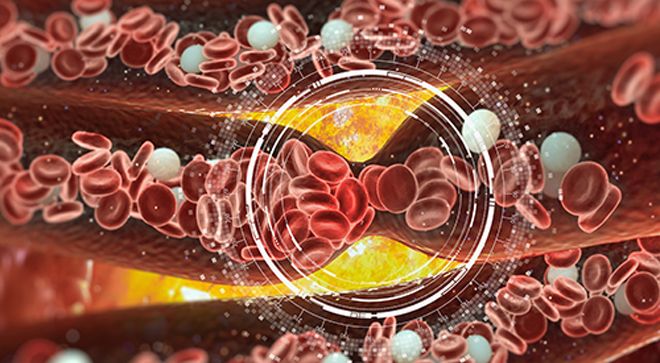News
Article
Many Patients With Breast Cancer Unaware of Their Increased Blood Clot Risk
Author(s):
One expert explained how patients with breast cancer have an increased risk for blood clots, even though one recently published survey determined that not many patients are aware of this.

According to findings of a survey published in the Journal of Thrombosis and Haemostasias, 61.8% of women who completed the survey were unaware of their risk for cancer-associated venous thromboembolism. In the patients who received information on this risk, 26.2% of them were informed of the risk at the time they were diagnosed with a cancer-related blood clot.
CURE® spoke with Dr. Jean Connors, a hematologist at Brigham and Women's Hospital and the Dana-Farber Cancer Institute, medical director of the hemostatic antithrombotic stewardship program and a professor of medicine at Harvard Medical School, to learn more about venous thromboembolism in patients with breast cancer, what may increase a patient’s risk for blood clots and how they may be treated.
What exactly is a venous thromboembolism?
I'm going to start by defining the arteries and the veins because that's important for understanding. The arteries take the blood away from the heart with oxygen and the veins bring it back after the oxygen has been delivered to the tissues. And they have different characteristics. The arteries are a little stiffer, stronger wall. The veins are a little more collapsible. … A lot of factors can lead up to venous thromboembolism, which is a blood clot in the vein.
Why is it that patients with breast cancer have a higher risk for developing them?
Patients who have any type of cancer have an increased risk of developing venous thromboembolism or a blood clot in the veins, due to several different factors that go along with the cancer. Some cancers are associated with a higher risk of blood clots like pancreatic (cancer). Some patients with breast cancer tend to develop blood clots with risk factors such as obesity or even smoking. Some of the treatments used for breast cancer, … hormonal agents or some other specific targeted therapies are associated with an increased risk of developing blood clots and certainly any extensive surgery or hospitalization and immobilization.
Even if the treatment for the breast cancer is associated with an increased risk of blood clots, the risk of blood clotting should not stand in the way of treating the cancer. It is so important to make sure you get the right treatment for the cancer. We have plenty of ways to prevent clots from forming, depending on what your risk is.
There are other factors like inherited risks for developing blood clots that a patient can have like a … mutation and a history of having had a blood clot. Say you broke your leg and you're in a cast and you got a blood clot; just having had a blood clot in the past means that you have an increased risk at baseline to develop a clot compared to other people. Sometimes we can’t identify those factors, but we know they're there.
Even though we know that patients with breast cancer may have an increased risk for venous thromboembolism, why is it that the survey found that two out of three patients were not aware of this elevated risk?
When patients are diagnosed with cancer, it’s a life-changing diagnosis. It's sometimes shocking and it is overwhelming. Many patients focus on treatments for their cancer and what needs to be done now. Many clinicians, medical oncologists and surgical oncologists taking care of these patients are so invested in making sure that the patients know about the treatments that they're getting, know the side effects of the treatments and managing all that complex oncology care, that bringing up the fact that they could get a blood clot is lower on the list. More and more, we're recognizing that dedicated services to help treat patients with blood clots and to identify people who are at risk for blood clots. … Hospitals and outpatients unites are developing materials to make people aware of clots.
If a patient with breast cancer develops a blood clot in their vein, how is that typically managed and are there any interactions with cancer treatment that might occur?
When someone is diagnosed as having a deep vein thrombosis or a pulmonary embolism, or a deep vein thrombosis in the heart, which can sometimes be associated with a portacath or catheters, people are treated with anticoagulation medications to prevent the clot from getting bigger and to allow the body to dissolve it. Once they have a very serious pulmonary embolus or significant swelling on the leg where they had drugs administered, they usually send them to dissolve the clot and sometimes even have it taken out surgically or with an interventional procedure. But the majority of patients, over 95% of patients, are treated with anticoagulant medications at therapeutic doses. These anticoagulants range the gamut from heparin, which is given by injection; unfractionated heparin, which is usually given by an intravenous drip in the hospital; and then oral medications such as warfarin, which has been around for 50 years and oral anticoagulants as Eliquis (apixaban), Xarelto (rivaroxaban) and Savaysa (edoxaban).
People are treated with these medications for at least three to six months, depending on how big the clot is and how severe it was. But then, at that time, a decision needs to be made about whether the patient would benefit from continued anticoagulation. That depends on whether they are still getting treatment for the cancer, whether the cancer is still present or whether they have other risk factors that are persisting like obesity or the body mass index over 30 or other medical illnesses or even if people have what we call residual vein thrombosis, meaning that after six months of therapeutic anticoagulation, they still have a clot left in the vein. People may have swelling related to this, and we call this post-thrombotic syndrome. People who have an increased risk for developing recurrent blood clots. And those patients with any of these factors such as persistent cancer, ongoing chemotherapy or targeted therapies, they often benefit from continued anticoagulation.
What advice would you give patients to potentially reduce their risk for blood clots?
The first (thing) is to know your family history. If there's anything in the history of thrombosis, less than 10% of the US population will have an inherited risk, but we believe that an inherited risk makes it easier for you get to get a blood clot, and the risk factors all add up. If you're a smoker, stop smoking. Obesity is a difficult one because many people are overweight and get cancer treatments. It makes it harder to lose weight sometimes. But movement is very, very important, walking, stretching. You don't have to go out and run miles, but just moving to get the blood flowing. … Staying hydrated is also important. But it's really the movement and not sitting in one position for too long. Knowing your risk factors and knowing the signs and symptoms of a blood clot because if you have a blood clot, recognizing it early and starting treatment quickly can sometimes — or so it seems — allow the clot to dissolve faster. It prevents it from causing more severe symptoms. The signs of a deep vein thrombosis in the leg are patients often complain of pain in the calf, like a charley horse or a cramp. They sometimes go, “I might have stepped off the curb funny or walked funny.” But this doesn't resolve. It doesn’t go away. It persists for a couple of hours or even a day or two. There's associated swelling. Sometimes people don't have any pain in the calf, but they get swelling in the lower leg or in the whole leg. The same is true for the arm. There's some swelling in the arm and the upper part of the arm or the hand. Their rings don’t fit as well. The arm is more swollen than the other side and it’s usually in the legs, too; one side is different from the other side and that’s the side that you might have a blood clot in that arm or leg.
A pulmonary embolus is associated with any of the following: chest pain, back pain and sometimes people think they have a pain on the side or in their back or under their shoulder blade or they have a little bit of pain in their chest. They don't think it's a heart attack, but they think maybe it’s indigestion. Sometimes shortness of breath. People notice it's harder to catch their breath when they're sitting or when they're going upstairs. They’re shorter of breath than they used to be. Coughing can be a sign of a blood clot. Certainly, more severe signs like coughing up blood or dizziness or lightheadedness and a racing heartbeat are signs of a more severe pulmonary embolism.
This transcript has been edited for clarity and conciseness.
For more news on cancer updates, research and education, don’t forget to subscribe to CURE®’s newsletters here.




